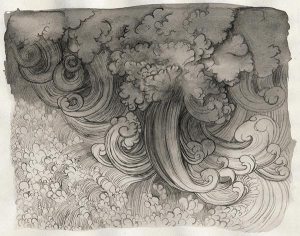
The photo above is verdigris pigment, PG20, that I made in a copper dish. The scratches were made with a stone to reveal the color.
The name verdigris comes from the French name for “green of Greece,” which is made from copper corrosion. It’s poisonous and from what I’ve read has problems with permanence and other issues, such as damaging paper, but from ancient times until the 19th century it was the most intense green available. Today it’s very rare to see anyone selling it, so yesterday afternoon I started this experiment to make my own.
This was done with a sheet of copper that I cut into a small circle and then hammered into a bowl shape. After that I poured into it a small amount of white vinegar for its acetic acid content. Apparently different vinegars will produce different greens, but this is the only one I’ve tried so far. I had read that a little salt is suppose to help, though I don’t know the specifics, so I also sprinkled in a little sea salt. Then I just left the dish in the sun. As it evaporated I could see a rim of dark green forming around the edge of the vinegar. I forgot to check it this morning, but when I looked in the afternoon everything had evaporated. There was still a bit of a vinegar smell though, and I don’t know if I should have waited longer before collecting the pigment.

Looking closely, the bottom of the dish had many green crystals on it. They were easy to scrap off and crush with a palette knife. I also poured in some more vinegar to see if more would form tomorrow, but in the course of making this post it already evaporated and it looks like there is more green in the dish already. Again though, I don’t know if I should let it sit longer.

I made a small amount of watercolor with that pigment, just using a palette knife, and then mixed it with lemon ochre in steps to see what it’d look like. The photo shows the paint a little lighter than it really is, but the hue and intensity are pretty close. Looking at the paint from different angles shows a lot of metallic glitter. Maybe that’s copper that didn’t fully corrode?
For the next part of this experiment I’ll get enough pigment to make some oil paint with it. Then I’ll try a different method in which the copper is placed in a jar with some vinegar in the bottom and left in the sun for a month as the vapor from it fills the jar and forms verdigris crystals on the copper. 🙂

Love it! It feels like being transported back to those times where we made paints like that – it seems like it must feel much more satisfying using ones own self-made paint :i I love what you do,painter:)
Yeah, and there’s so many possibilities to experiment that are a lot of fun too. I’ve added some rice vinegar to a second dish to see how well that works. The examples I’m looking at show it being successful, but with a different color. 🙂
this experimenting and improvising – I think it is why we are really here, in this world -to experiencing it all – and how better do that, than in our art – bless you for giving me so much pleasure 🙂
I’ve been thinking it over, and my thoughts are that rather than us being here to experience the world, it’s the world that was prepared to be experienced by us. We, in turn, are here because it’s the will of God, considering the verse- “You are worthy, our Lord and God, to receive glory and honor and power, for you created all things, and by your will they were created and have their being.” (Revelation 4:11, NIV translation)
I’m glad that you enjoy what I do. Today I collected more pigment and made a little oil paint with it. 🙂
Organic. Lovely. My green paints are so…meh. This has character. Love it. Great job.
Thanks 🙂
There’s so few green pigments out there in use today that many green paints in each brand’s selection are actually just mixes of phthalo green with one or more other pigments, but there’s several “lost” greens like this with their own characters. They got replaced by modern alternatives that were more reliable or less toxic, which aren’t bad reasons for replacing them, but it’s fun to experience what past artists used.
Fabulous colours
Thanks, and I got another color later too from a second pigment batch. It was greener than what’s seen here. 🙂